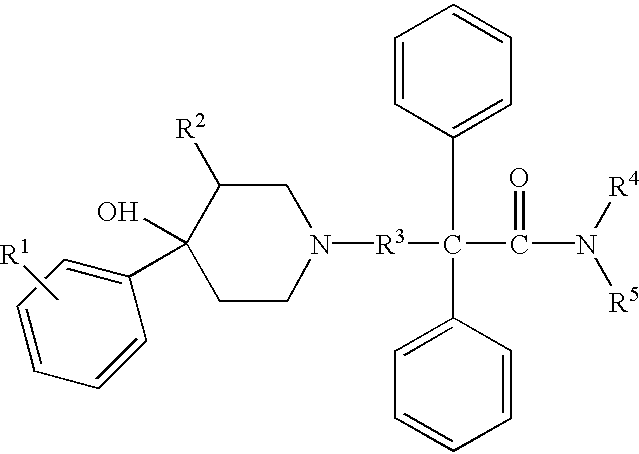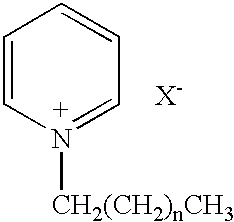Pharmacological inducement of the fed mode for enhanced drug administration to the stomach
- Summary
- Abstract
- Description
- Claims
- Application Information
AI Technical Summary
Benefits of technology
Problems solved by technology
Method used
Image
Examples
example 1
[0118]Four dogs, all male beagles ranging in age from 10 months to 21 months and weighing from 6 kg to 10 kg each, were housed individually and each was fed a 1:1 (weight ratio) wet:dry mixture of food weighing 300 g once daily at 3:00 p.m. Water was provided ad libitum. The dogs were fasted for 6-8 hours overnight, preceded by the removal of feces and any uneaten food.
[0119]Test formulations were administered in various regimens. In some of the tests, the dogs were given an immediate release (IR) regimen in the form of a single gelatin capsule containing a test species in a selected amount. A simulated controlled release (SCR) regimen was used in other tests by administering a gelatin capsule containing a test species in a selected amount every half hour. A third regimen was a controlled release (CR) regimen, in which the test species was incorporated in a compressed tablet of POLYOX 303 and magnesium stearate. (The arginine controlled-release dosage form, for example, contained 30...
example 2
[0122]Further tests were performed on a second group of dogs, consisting of five female beagles one year in age and weighing 5-7 kg each. The test protocols were the same as those in Example 1 except that the dogs were fasted for 24 hours before each test, and the test results are listed in Table II below, which lists the mean of the results observed among the five dogs as well as the range among the dogs for each test.
[0123]
TABLE IIFed Mode Inducing Agentsand Resulting Retention Times for 7.94 × 19.05 mm BaSO4 TabletRetention Time (h)Test AgentDosage (mg)RegimenMeanRangeNone-fasted——1.0 ± 0.20.75-1.25(Negative Control)None-fed——5.4 ± 0.94-6(Positive Control)Trp-Trp5SCR(a)4.6 ± 1.52.25-5.75Trp-Trp10SCR(b)2.4 ± 1.80.25-4.75Trp-Trp40SCR(c)3.4 ± 1.91.25-5.25Cetylpyridinium20IR4.5 ± 2.60.75-6.75chlorideCetylpyridinium50IR4.0 ± 1.31.75-4.75chlorideCetylpyridinium100IR3.2 ± 0.92.75-4.25chlorideGentian root200IR2.6 ± 1.41.25-4.75(gentisic acid)(a)Simulated controlled release was achieved b...
example 3
[0124]Further tests were performed on the second group of dogs, consisting of five female beagles one year in age and weighing 5-7 kg each. The test protocols were the same as those in Example 2, except that the controls were replaced by a negative control consisting of AVICEL (microcrystalline cellulose, FMC Corporation, Philadelphia, Pa., USA), administered as a simulated controlled release at 10 mg every half hour. The test results are listed in Table III below, which lists the mean of the results observed among the five dogs as well as the range among the dogs for each test.
[0125]
TABLE IIIFed Mode Inducing Agentsand Resulting Retention Times for 7.94 × 19.05 mm BaSO4 TabletRetention Time (h)Test AgentDosage (mg)RegimenMeanRangeAVICEL10SCR(a)1.4 ± 0.60.75-1.75(Negative Control)Cetylpyridinium20IR4.45 ± 2.6 0.75-6.75chlorideCetylpyridinium5IR4.0 ± 2.80.25-6.25chlorideGlycine20SCR(b)3.3 ± 1.31.75-5.25hemihydrochlorideGlycine50SCR(c)3.8 ± 2.60.75-5.75hemihydrochlorideGlycine5SCR(d)4...
PUM
| Property | Measurement | Unit |
|---|---|---|
| Weight | aaaaa | aaaaa |
| Mass | aaaaa | aaaaa |
| Mass | aaaaa | aaaaa |
Abstract
Description
Claims
Application Information
 Login to View More
Login to View More - R&D
- Intellectual Property
- Life Sciences
- Materials
- Tech Scout
- Unparalleled Data Quality
- Higher Quality Content
- 60% Fewer Hallucinations
Browse by: Latest US Patents, China's latest patents, Technical Efficacy Thesaurus, Application Domain, Technology Topic, Popular Technical Reports.
© 2025 PatSnap. All rights reserved.Legal|Privacy policy|Modern Slavery Act Transparency Statement|Sitemap|About US| Contact US: help@patsnap.com



